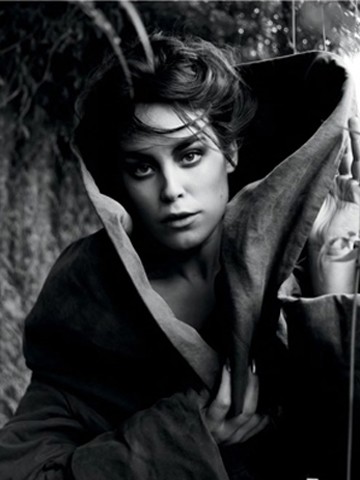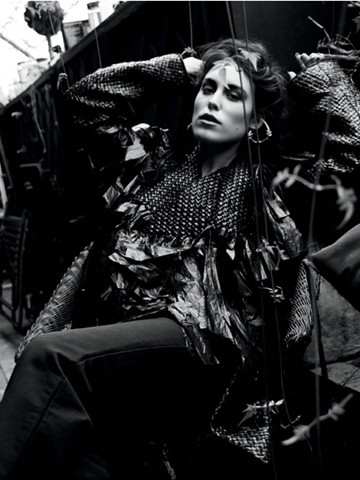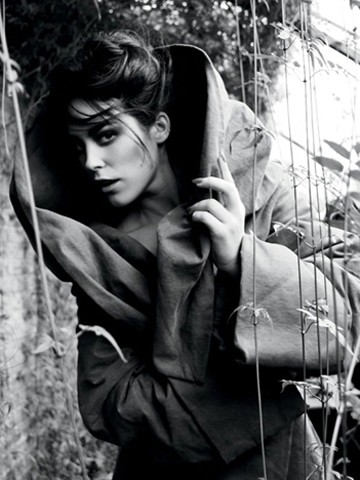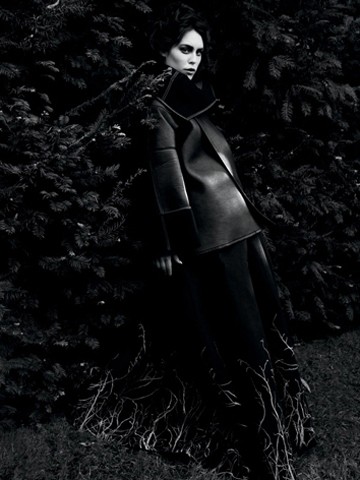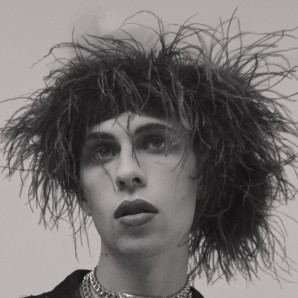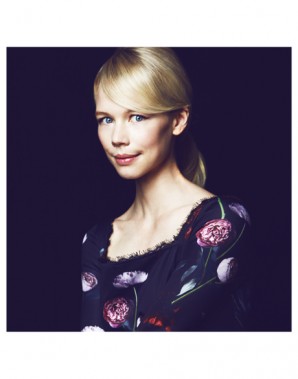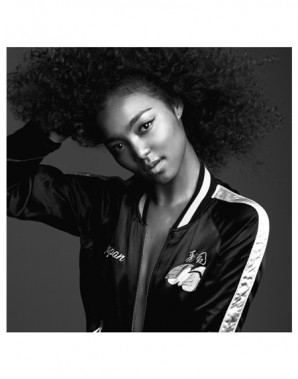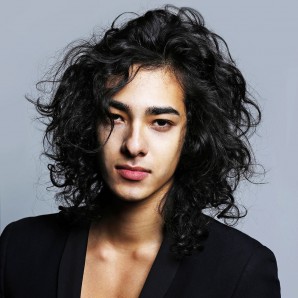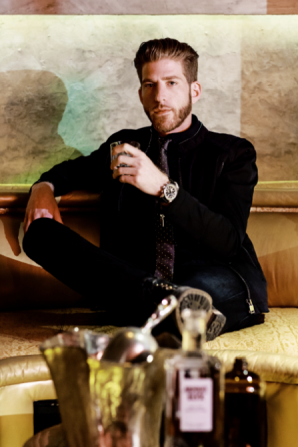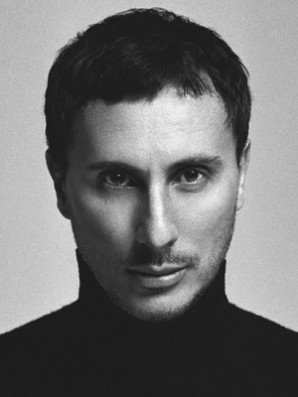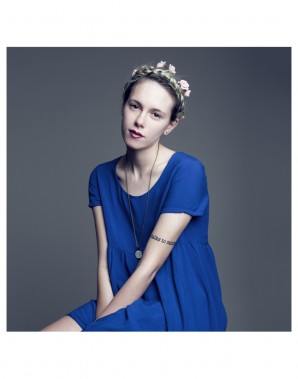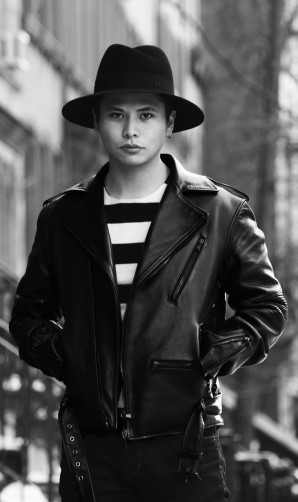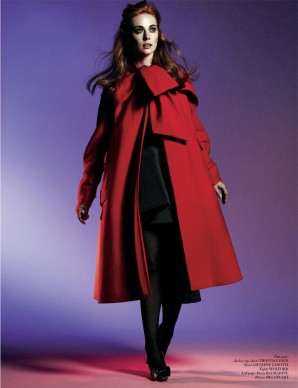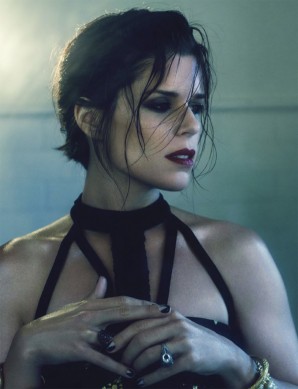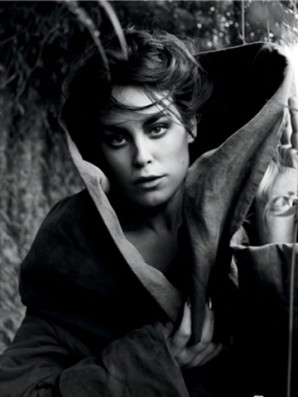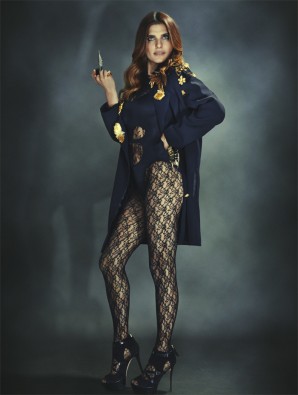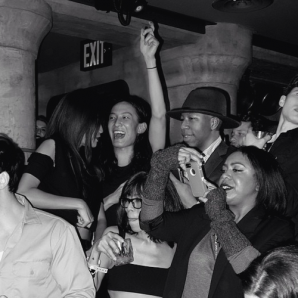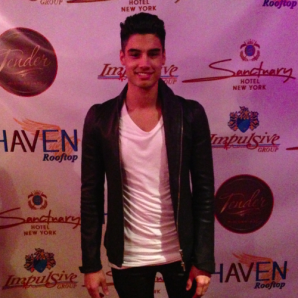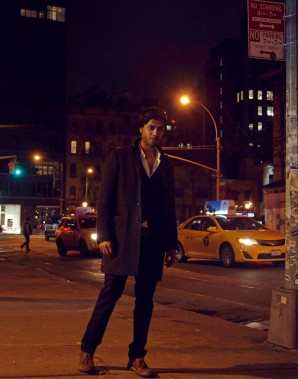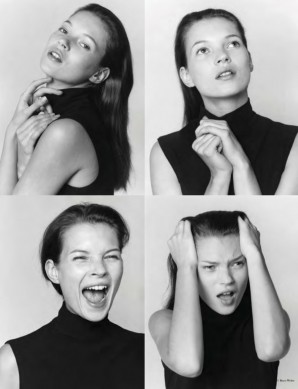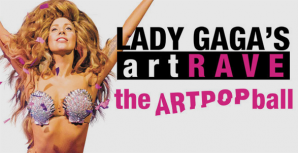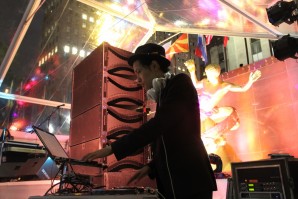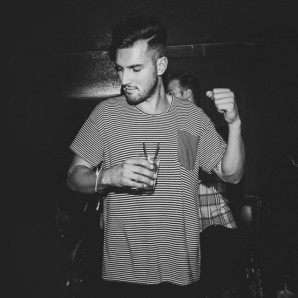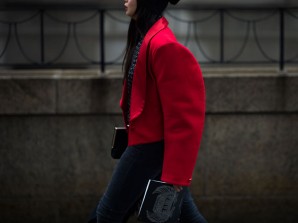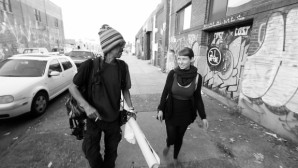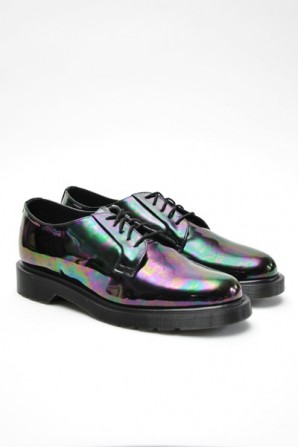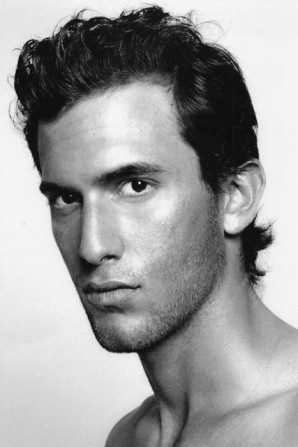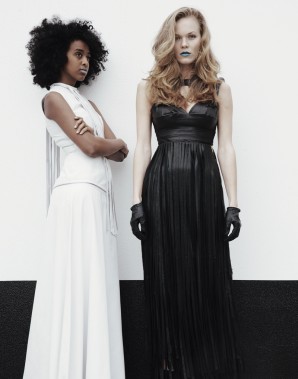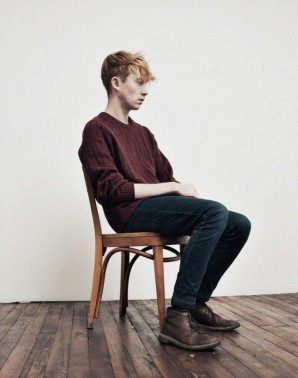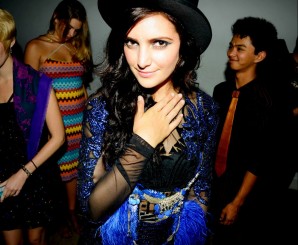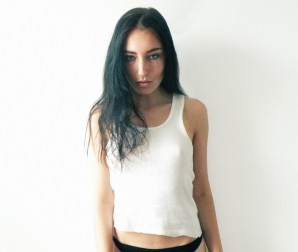TWELV takes a step back and visits the masterminds behind the camera.
GARETH PUGH: ORGANIZED CHAOS
Gareth Pugh is a study in contrasts; balancing the demands of what is created and what is worn; what is in a designer’s control and what is in the hands of the wearer; what must be planned and what must be left to chaos. Recently Pugh’s work conveys a comfort level in what he does and how it exists in the larger context of fashion. No longer focused on pure shock value, Pugh recently spoke with TWELV about his creative process and the fashion industry, as well as the increasing sense of maturity exhibited in his creations. His good friend Tallulah Harlech, daughter of Chanel muse Lady Amanda Harlech and actress in Ralph Fiennes' new film "The Invisible Woman", showcases Pugh's newest designs in a lush garden in London.
What is your process in creating a collection? Do you need to contemplate an idea for a long time, do you create from instinct and a generative process, or is it a bit of both?
It’s actually a bit of both. I do tend to think about things a great deal, but there are moments- happy accidents lets say- that can trigger a whole new direction for an entire collection. It’s very dangerous, of course, to rely on these moments, so I always like to create a solid basis, a sort of abstract narrative that could be as basic as a sense, or a feeling, to work from. It is very rarely something tangible, and usually very difficult for me to communicate this narrative to anyone else, but things begin to solidify and crystallize as we work on the various elements of the show. It is very satisfying for me when all the elements come together and form a complete image.
Your work seems to be centered on a type of creative narrative, or a type of story that is communicating an abstracted idea. What role do you see that type of fashion playing in the wider scope of the fashion industry?
Everyone can relate to a story, no matter how abstract. Take away the story, and what you are left with is simply an aesthetic. An aesthetic is very easy to disengage from, while a narrative has the potential to become more ingrained, and feels like its part of something real, something physical, which ultimately is what makes fashion desirable. I would like to think that people want to be part of something that transcends the surface, and experience something that feels steeped in a certain ideology.
Where do you see fashion going in the future? Do you see artistic or conceptual approaches to fashion becoming more important?
It’s easy to feel a little despondent about fashion at the moment. I do think that there needs to be some sort of seismic shift – a total re-evaluation of what we value and look towards.
What are your views on the turnover of fashion? As an art-related designer do you wish that you had a seasonless time limit to develop ideas, or do you feel that the rigid pace of seasons keeps you motivated and focused?
Having such rigid deadlines is something that I am used to, and also think is very necessary. If I was afforded all the time in the world to work on something before letting it go, it would be impossible to actually do so. Nothing is ever perfect, and though this is a difficult lesson to learn, you very quickly realize that this sense of dissatisfaction is what spurs you on to do the next thing; a constant and never ending search for perfection. I like being able to build something up, then completely destroy it and start fresh. There is definitely something quite sadistic in this approach, yet being able to develop a visual language, and discover new ways of doing things along the way makes the process easier as time goes on.
How do you wish your customer to interact with the clothing that you create for her beyond the corporeal? What are you hoping that she feels when wearing your clothing?
Once you set something free, you lose control. What I wish for in this respect is immaterial.
What is the significance of gray, black, blue, and white in your work?
It’s simply about minimizing visual noise, and an attempt to offer an idea in its most basic form.
Many of your clothes are architectural and mathematical in structure. What is the relationship between the body and the angularity of your work?
It is more to do with a desire for control. Out of a sometimes very chaotic process comes this definite yearn for clarity. This is something that undoubtedly permeates the clothes.
You are able to deftly wrap the body in volumes of fabric without overwhelming the wearer. Can you explain the symbolism that you see behind that?
I don't like to overthink each and every aspect of what I do, that’s very important, it allows me a certain freedom to do something because it feels right, rather than constantly thinking about what it means to do it. I would argue that that’s not necessarily part of my role, as self-awareness at a certain level is an important asset, but taken too far can be very dangerous.
What designer’s work most often attracts your attention or has an influence on your own work? Do you feel it is more or less relevant to look at historical dress versus contemporary work?
That’s a difficult question to answer. I would describe my taste as that of a schizophrenic magpie.
Do you think the fashion press generally understands your work, or do you think that they miss the mark?
There are definitely certain people who get it, and who take the time to actually understand it rather than simply look, though that’s not really something that bothers me. If I'm pleasing everyone, I’m definitely doing something very wrong indeed.
You work with a lot of the same people each season in support of your fashion show presentations. Is it more collaborative in nature, or are most of the choices a part of your vision that they carry out?
I usually have very definite ideas about how I want things to be. I work with people that I like – that’s very important to me – people that I feel comfortable with and people who are able to execute these ideas.
Would you say that you have a muse? What does the term muse mean to you?
My idea of a muse is a little idealistic, and that of someone who totally and without question inhabits the fantasy. My notion of a muse goes far beyond a person who simply wears the clothes and/or has a particular attitude that fits a certain designer or collection. A muse for me is someone who sacrifices themselves, who throws themselves on the fire like a phoenix.
By: Noel Palomo-Lovinski
Photography: Jessie Craig
Hair: Isabella Boettcher @ Terri Manduca. Makeup: Natsumi Minarita @ Untitled Artists. London using MAC. Manicurist: Ami Streets @LMC Worldwide using The New Black.
*This story was featured in TWELV's Fall/Winter 2013 Issue
related posts
IKEMEN #24: LUKE ABBY
IKEMEN (ē´k´mɛn): Japanese Slang
"REALLY, REALLY, RIDICULOUSLY GOOD LOOKING PEOPLE"
ERIN FETHERSTON EXCLUSIVE INTERVIEW
NAME: Erin Fetherston
ORIGIN: California
OCCUPATION: Fashion Designer
CRYSTAL KAY EXCLUSIVE INTERVIEW
NAME: Crystal Kay
ORIGIN: Yokohama, Japan
OCCUPATION: Performer and musician
IKEMEN #23: ANSONI
IKEMEN (ē´k´mɛn): Japanese Slang
"REALLY, REALLY, RIDICULOUSLY GOOD LOOKING PEOPLE"
IKEMEN #22: ADAM SPOONT
IKEMEN (ē´k´mɛn): Japanese Slang
"REALLY, REALLY, RIDICULOUSLY GOOD LOOKING PEOPLE"
BABËL New York Celebrates 1 Year Anniversary With Two Day Event of Excess and Splendor
BABEL NEW YORK acclaimed the NYC party scene in celebration of their First Year Anniversary. As temperatures begin to heat up in NYC, there is no better locale than the much desired rooftop.
BEHIND THE SCENES #2: LUIGI MURENU
TWELV's Behind the Scenes takes a step back and visits the masterminds behind the camera.
IKEMEN #21: MICHELLE VON MANDEL
IKEMEN (ē´k´mɛn): Japanese Slang
"REALLY, REALLY, RIDICULOUSLY GOOD LOOKING PEOPLE"
IKEMEN #20: GEORGE INAKI
IKEMEN (ē´k´mɛn): Japanese Slang
"REALLY, REALLY, RIDICULOUSLY GOOD LOOKING PEOPLE"
DEBORAH ANN WOLL: ALL THE WORLD'S A STAGE
Deborah Ann Woll’s voice glows when she speaks, as warm and full as her golden red hair.
NEVE CAMPBELL: LOSE YOURSELF TO DANCE
Carrying over two decades of the industry on her back, there aren’t many women with the grace and stoicism of Neve Campbell.
GARETH PUGH: ORGANIZED CHAOS
Gareth Pugh is a study in contrasts; balancing the demands of what is created and what is worn; what is in a designer’s control and what is in the hands of the wearer; what must be planned and...
LAKE BELL: THE GREAT LAKE
Lake Bell has made a name for herself as a charming, beautiful, and witty New Yorker capable of indie and blockbuster success (“It’s Complicated”, “No Strings Attached”, “Children’s Hospital...
FRIDAY'S FW PARTY
With Fashion Week’s second day over, Friday night was primetime for some of the most prominent designer to celebrate their successes over a glass of champagne.
IKEMEN #19: SAMAR SAJJAD
IKEMEN (ē´k´mɛn): Japanese Slang
"REALLY, REALLY, RIDICULOUSLY GOOD LOOKING PEOPLE"
Happy Birthday, Kate the Great!
Happy birthday to everyone’s favorite super model Kate Moss. The Brit enters her 40th year with grace, and she looks better than ever.
Lady Gaga's ArtPop Ball
Lady Gaga is back, and this time, it’s not just to perform.
IKEMEN #18: KEIICHIRO NAKAJIMA
IKEMEN (ē´k´mɛn): Japanese Slang
"REALLY, REALLY, RIDICULOUSLY GOOD LOOKING PEOPLE"
IKEMEN #16: KAROLYN PHO
IKEMEN (ē´k´mɛn): Japanese Slang
"REALLY, REALLY, RIDICULOUSLY GOOD LOOKING PEOPLE"
Futura Bold
Futura came up in the grimy, visceral environment of New York City’s early 1970’s street culture of tagging, bombing and writing graffiti – making their art not in the city, but on top of it.
FROM AUSTRALIA WITH LOVE: WHAT I'VE LEARNED SO FAR
Buyer’s Regret: It’s just like buyer’s remorse only in reverse. And it is a fashion crime that I have and will probably continue to commit time and time again.
IKEMEN #15: EDOARDO IANNUZZI
IKEMEN (ē´k´mɛn): Japanese Slang
"REALLY, REALLY, RIDICULOUSLY GOOD LOOKING PEOPLE"
FROM AUSTRALIA WITH LOVE: Designer Profile of Gabriella Ferrante
I find that Australia’s fashion industry can sometime be accused of playing catch-up with other, bigger and more cosmopolitan locations (i.e. Paris, London etc…) This needn’t be the case.
IKEMEN #14: Joao Veiga de Aguiar
IKEMEN (ē´k´mɛn): Japanese Slang
"REALLY, REALLY, RIDICULOUSLY GOOD LOOKING PEOPLE"
FROM AUSTRALIA WITH LOVE: PRETTY BOYS DON'T BUY THEIR OWN DRINKS
Its no secret if you know me – I like to drink.
IKEMEN #13: NATALIE O'BRIEN
IKEMEN (ē´k´mɛn): Japanese Slang
"REALLY, REALLY, RIDICULOUSLY GOOD LOOKING PEOPLE"
IKEMEN #12: KRISTIN PRIM
IKEMEN (ē´k´mɛn): Japanese Slang
"REALLY, REALLY, RIDICULOUSLY GOOD LOOKING PEOPLE"
ARTIST, MODEL, AND LIVING PIECE OF ART: ZOMBIE BOY
From Zombie Boy to living icon, Rick Genest isn’t just Nicola Formichetti’s muse anymore.
IKEMEN #11: JAY PAAVONPERA
IKEMEN (ē´k´mɛn): Japanese Slang
"REALLY, REALLY, RIDICULOUSLY GOOD LOOKING PEOPLE"
DON'T CALL DELANO BROWN A DESIGNER
TWELV met up with the always-unpredictable artist Delano Brown for lunch in Bryant Park.
IKEMEN #10: LOGAN NEITZEL
IKEMEN (ē´k´mɛn): Japanese Slang
"REALLY, REALLY, RIDICULOUSLY GOOD LOOKING PEOPLE"
Rocco Leo Gaglioti
Who are you?
Rocco Leo Gaglioti Creator/Host of Fashion News Live and Owner/CEO of RLG Productions, Corp.
NICOLA FORMICHETTI TUMBLR MEETUP HIGHLIGHTS
“My job feels more like a hobby than a job, really; it’s always fun,” says Nicola Formichetti for TWELV’s second issue.

